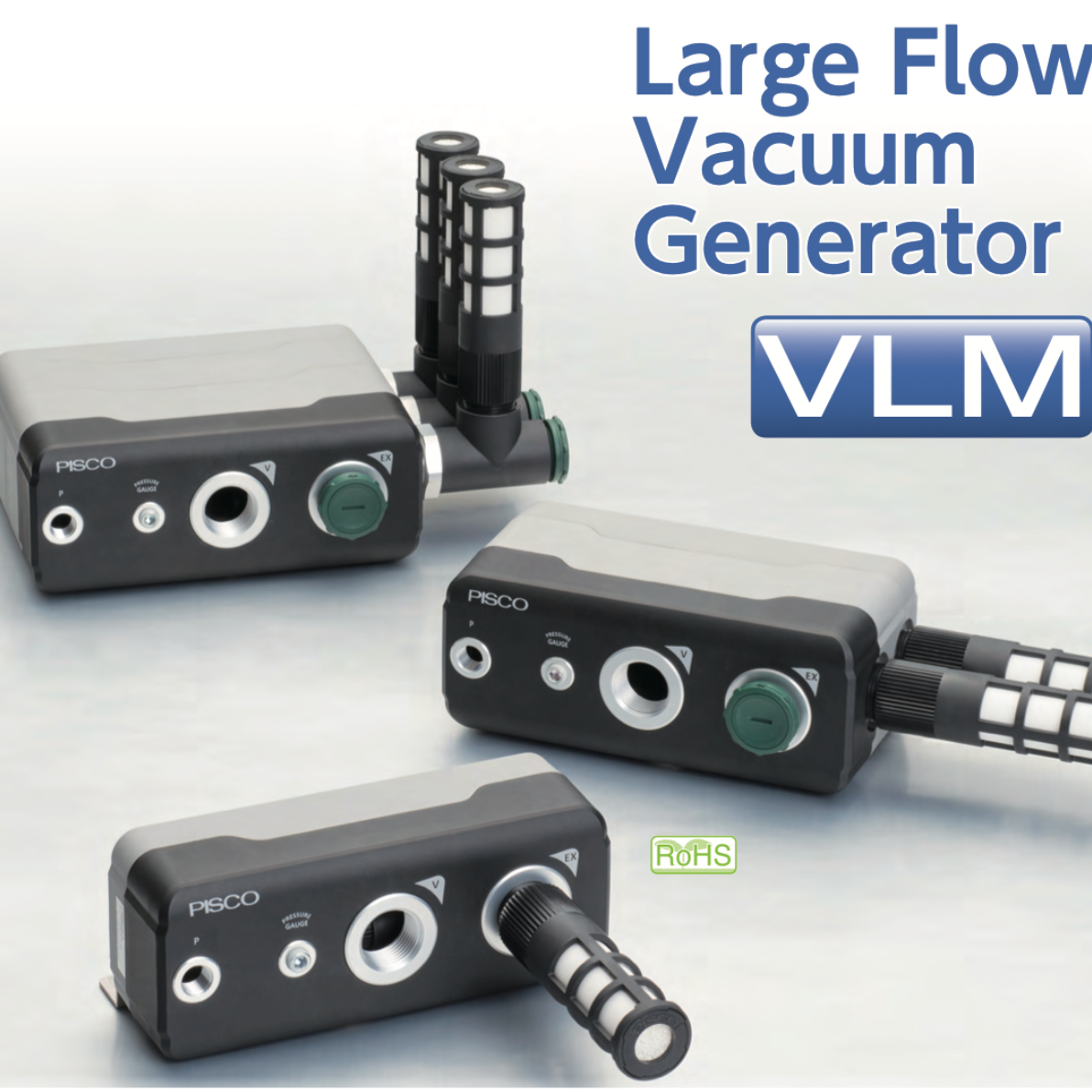How Venturi Vacuum Pumps Work: Complete Guide for Industrial Automation and Robotics Introduction Venturi vacuum pumps are compact pneumatic devices that use compressed air to generate a vacuum—without any moving parts, electric motors, or lubrication. They are widely used in industrial automation and robotics for pick-and-place applications, packaging, and material handling. In Indian industries where precision, reliability, and speed are critical, Venturi vacuum pumps provide a clean, energy-efficient, and low-maintenance solution for vacuum generation. This complete guide explains how they work, their types, advantages, and how to select the right pump for your automation system. What Is a Venturi Vacuum Pump? A Venturi vacuum pump, also called a vacuum ejector or pneumatic vacuum generator, operates using the Venturi principle — a fundamental fluid dynamics concept. When compressed air flows through a specially designed nozzle, it accelerates and creates a low-pressure area, which produces vacuum suction. This vacuum can then be used to power suction cups, grippers, or vacuum pads that lift and move objects without mechanical contact — making it ideal for robotic automation systems. Working Principle of a Venturi Vacuum Pump The working principle is simple yet powerful. It follows Bernoulli’s principle and the Venturi effect: Compressed Air Inlet: Air enters through a nozzle under pressure. Acceleration: As it passes through a narrow throat, the airspeed increases dramatically. Pressure Drop: The high-speed air creates a low-pressure zone (vacuum). Suction: Air from the suction port is drawn into this low-pressure region. Exhaust: The combined air stream exits through the diffuser, completing the vacuum cycle. This process occurs in milliseconds, enabling high-speed vacuum generation essential for robotic pick-and-place or packaging operations. Types of Venturi Vacuum Pumps Venturi pumps come in several configurations, each suited to specific applications: 1. Single-Stage Ejectors Simple, cost-effective design. Suitable for quick vacuum generation in basic automation setups. 2. Multi-Stage Ejectors Use multiple nozzles in series to deliver higher vacuum flow and deeper vacuum levels—ideal for large parts or porous materials. 3. Inline Type Compact and lightweight, installed directly between pneumatic lines. Preferred for robotic end-of-arm tools due to space efficiency. 4. Cartridge-Type Designed for integration into custom manifolds. Common in multi-gripper or modular vacuum systems used by OEMs. 5. Ejectors with Blow-Off Function Include an integrated air-blow release to rapidly drop parts, improving cycle time and production speed. Applications in Automation and Robotics Venturi vacuum pumps are used across diverse industries: Robotic Pick-and-Place Systems: Lifting small or large parts quickly and accurately. Packaging & Logistics: Handling bags, cartons, pouches, and bottles. Automotive Industry: Sheet metal handling, glass installation, and component transfer. Electronics & Semiconductor: Precise handling of wafers, PCBs, or delicate assemblies. Food & Pharmaceutical: Hygienic material handling with FDA-grade suction cups. Because they use compressed air instead of electricity, they are safer and more reliable in high-speed or sensitive environments. Selection Guide – Choosing the Right Venturi Pump When selecting a Venturi vacuum pump, engineers should consider: Required Vacuum Level: Based on material weight and surface area. Air Consumption: Energy-efficient designs reduce operating costs. Response Time: Faster pumps support higher cycle rates. Mounting Configuration: Inline, manifold, or standalone module. Operating Environment: Temperature, dust level, and cleanliness. Optional Features: Integrated filters, silencers, or sensors for automation feedback. Top Global Brands for Venturi Vacuum Pumps Leading international manufacturers supply high-quality Venturi pumps to the Indian market: PISCO (Japan): Compact, energy-efficient ejectors with integrated blow-off and silencer options. Piab (Sweden): COAX® multi-stage technology with superior vacuum efficiency. Schmalz (Germany): Smart vacuum generators with energy monitoring and feedback control. SMC (Japan): Inline and manifold-mounted ejectors optimized for robotics. Festo (Germany): Modular vacuum systems offering precise control and reliability. Coval (France): Intelligent vacuum pumps with digital performance monitoring. Each brand offers specialized models suited for packaging, assembly, and cleanroom operations. Advantages of Using Venturi Vacuum Pumps Compact and Lightweight: Easy integration into robotic arms or pneumatic panels. No Moving Parts: Maintenance-free, reliable operation. Fast Response: Ideal for high-speed pick-and-place automation. Clean Operation: No oil or electrical components—safe for cleanroom use. Energy Efficient: Consumes air only during vacuum generation, reducing cost.
Chat with us on WhatsApp
×
This is your website preview.
Currently it only shows your basic business info. Start adding relevant business details such as description, images and products or services to gain your customers attention by using Boost 360 android app / iOS App / web portal.
https://www.ibizkart.in/gurgaon/latest-update/how-venturi-vacuum-pumps-work-complete-guide-for-industrial-automation-and-robotics/532
How Venturi Vacuum Pumps Work: Complete Guide for Industrial Automation and Robotics

2025-10-11T23:29:18
How Venturi Vacuum Pumps Work: Complete Guide for Industrial Automation and Robotics Introduction Venturi vacuum pumps are compact pneumatic devices that use compressed air to generate a vacuum—without any moving parts, electric motors, or lubrication. They are widely used in industrial automation and robotics for pick-and-place applications, packaging, and material handling. In Indian industries where precision, reliability, and speed are critical, Venturi vacuum pumps provide a clean, energy-efficient, and low-maintenance solution for vacuum generation. This complete guide explains how they work, their types, advantages, and how to select the right pump for your automation system. What Is a Venturi Vacuum Pump? A Venturi vacuum pump, also called a vacuum ejector or pneumatic vacuum generator, operates using the Venturi principle — a fundamental fluid dynamics concept. When compressed air flows through a specially designed nozzle, it accelerates and creates a low-pressure area, which produces vacuum suction. This vacuum can then be used to power suction cups, grippers, or vacuum pads that lift and move objects without mechanical contact — making it ideal for robotic automation systems. Working Principle of a Venturi Vacuum Pump The working principle is simple yet powerful. It follows Bernoulli’s principle and the Venturi effect: Compressed Air Inlet: Air enters through a nozzle under pressure. Acceleration: As it passes through a narrow throat, the airspeed increases dramatically. Pressure Drop: The high-speed air creates a low-pressure zone (vacuum). Suction: Air from the suction port is drawn into this low-pressure region. Exhaust: The combined air stream exits through the diffuser, completing the vacuum cycle. This process occurs in milliseconds, enabling high-speed vacuum generation essential for robotic pick-and-place or packaging operations. Types of Venturi Vacuum Pumps Venturi pumps come in several configurations, each suited to specific applications: 1. Single-Stage Ejectors Simple, cost-effective design. Suitable for quick vacuum generation in basic automation setups. 2. Multi-Stage Ejectors Use multiple nozzles in series to deliver higher vacuum flow and deeper vacuum levels—ideal for large parts or porous materials. 3. Inline Type Compact and lightweight, installed directly between pneumatic lines. Preferred for robotic end-of-arm tools due to space efficiency. 4. Cartridge-Type Designed for integration into custom manifolds. Common in multi-gripper or modular vacuum systems used by OEMs. 5. Ejectors with Blow-Off Function Include an integrated air-blow release to rapidly drop parts, improving cycle time and production speed. Applications in Automation and Robotics Venturi vacuum pumps are used across diverse industries: Robotic Pick-and-Place Systems: Lifting small or large parts quickly and accurately. Packaging & Logistics: Handling bags, cartons, pouches, and bottles. Automotive Industry: Sheet metal handling, glass installation, and component transfer. Electronics & Semiconductor: Precise handling of wafers, PCBs, or delicate assemblies. Food & Pharmaceutical: Hygienic material handling with FDA-grade suction cups. Because they use compressed air instead of electricity, they are safer and more reliable in high-speed or sensitive environments. Selection Guide – Choosing the Right Venturi Pump When selecting a Venturi vacuum pump, engineers should consider: Required Vacuum Level: Based on material weight and surface area. Air Consumption: Energy-efficient designs reduce operating costs. Response Time: Faster pumps support higher cycle rates. Mounting Configuration: Inline, manifold, or standalone module. Operating Environment: Temperature, dust level, and cleanliness. Optional Features: Integrated filters, silencers, or sensors for automation feedback. Top Global Brands for Venturi Vacuum Pumps Leading international manufacturers supply high-quality Venturi pumps to the Indian market: PISCO (Japan): Compact, energy-efficient ejectors with integrated blow-off and silencer options. Piab (Sweden): COAX® multi-stage technology with superior vacuum efficiency. Schmalz (Germany): Smart vacuum generators with energy monitoring and feedback control. SMC (Japan): Inline and manifold-mounted ejectors optimized for robotics. Festo (Germany): Modular vacuum systems offering precise control and reliability. Coval (France): Intelligent vacuum pumps with digital performance monitoring. Each brand offers specialized models suited for packaging, assembly, and cleanroom operations. Advantages of Using Venturi Vacuum Pumps Compact and Lightweight: Easy integration into robotic arms or pneumatic panels. No Moving Parts: Maintenance-free, reliable operation. Fast Response: Ideal for high-speed pick-and-place automation. Clean Operation: No oil or electrical components—safe for cleanroom use. Energy Efficient: Consumes air only during vacuum generation, reducing cost.
2025-10-11T23:29:18
Keywords
- Industrial vacuum pumps for electronics
- High-speed vacuum generation systems
- Vacuum pumps for packaging and logistics
- No-moving-parts vacuum pumps advantages
- Compact vacuum pumps for pick-and-place
- Energy-efficient vacuum generation solutions
- Vacuum ejectors for robotics applications
- Multi-stage Venturi ejector types
- Pneumatic vacuum generator working principle
- Venturi vacuum pumps for industrial automation

Submit Your Enquiry